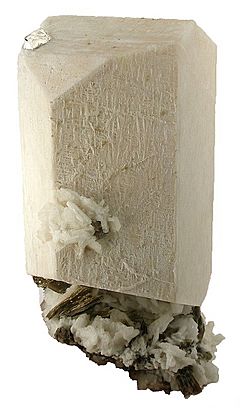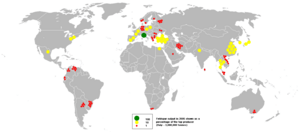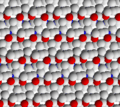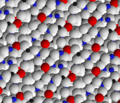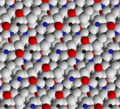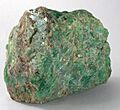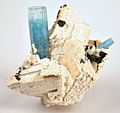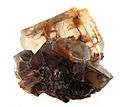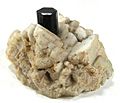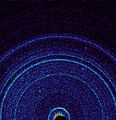Feldspar facts for kids
|
||||||||||||||||||||||||||||||||||||||||
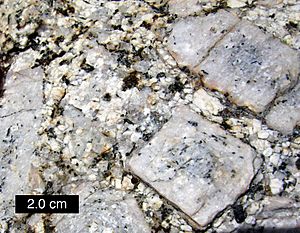
Feldspar is the name of a group of rock-forming minerals that make up as much as 60% of the Earth's crust.
Feldspar forms crystals from magma in both intrusive and extrusive rocks, and they can also happen as compact minerals, as veins, and are also present in many types of metamorphic rock. Rock formed entirely of plagioclase feldspar is known as anorthosite. Feldspar is also found in many types of sedimentary rock.
Feldspar is typically reddish or pale pink in color, and has a hardness of 6 on the Mohs scale, making it roughly as hard to scratch as glass.
There are two groups of feldspar, both made out of silica and aluminum:
- Orthoclase or "alkali" feldspars: a group of minerals that all have the same formula (KAlSi3O8 with sodium sometimes replacing the potassium in some pieces), but are formed in different ways because of how different the times and places where they formed were.
- Plagioclase feldspars: A series of minerals that are made up of a series of two chemicals (Albite, NaAlSi3O8, and anorthite CaAl2Si2O8), with a given piece having its place on the series determined by the relative amounts of the two chemicals.
Etymology
The name feldspar derives from the German Feldspat, a compound of the words Feld ("field") and Spat ("flake"). Spat had long been used as the word for "a rock easily cleaved into flakes"; Feldspat was introduced in the 18th century as a more specific term, referring perhaps to its common occurrence in rocks found in fields (Urban Brückmann, 1783) or to its occurrence as "fields" within granite and other minerals (René-Just Haüy, 1804). The change from Spat to -spar was influenced by the English word spar, meaning a non-opaque mineral with good cleavage. Feldspathic refers to materials that contain feldspar.
Weathering
Chemical weathering of feldspars happens by hydrolysis and produces clay minerals, including illite, smectite, and kaolinite. Hydrolysis of feldspars begins with the feldspar dissolving in water, which happens best in acidic or basic solutions and less well in neutral ones. The speed at which feldspars are weathered is controlled by how quickly they are dissolved. Dissolved feldspar reacts with H+ or OH− ions and precipitates clays. The reaction also produces new ions in solution, with the variety of ion controlled by the type of feldspar reacting.
The abundance of feldspars in the Earth's crust means that clays are very abundant weathering products. About 40% of minerals in sedimentary rocks are clays, and clays are the dominant minerals in the most common sedimentary rocks, mudrocks. They are also an important component of soils. Feldspar that has been replaced by clay looks chalky compared to more crystalline and glassy unweathered feldspar grains.
Feldspars, especially plagioclase feldspars, are not very stable at the earth's surface due to their high formation temperature. This lack of stability is why feldspars are easily weathered to clays. Because of this tendency to weather easily, feldspars are usually not prevalent in sedimentary rocks. Sedimentary rocks that contain large amounts of feldspar indicate that the sediment did not undergo much chemical weathering before being buried. This means it was probably transported a short distance in cold and/or dry conditions that didn't promote weathering, and that it was quickly buried by other sediment. Sandstones with large amounts of feldspar are called arkoses.
Production and uses
About 20 million tonnes of feldspar were produced in 2010, mostly by three countries: Italy (4.7 Mt), Turkey (4.5 Mt), and China (2 Mt).
Feldspar is a common raw material used in glassmaking, ceramics, and to some extent as a filler and extender in paint, plastics, and rubber. In glassmaking, alumina from feldspar improves product hardness, durability, and resistance to chemical corrosion. In ceramics, the alkalis in feldspar (calcium oxide, potassium oxide, and sodium oxide) act as a flux, lowering the melting temperature of a mixture. Fluxes melt at an early stage in the firing process, forming a glassy matrix that bonds the other components of the system together. In the US, about 66% of feldspar is consumed in glassmaking, including glass containers and glass fibre. Ceramics (including electrical insulators, sanitary ware, pottery, tableware, and tile) and other uses, such as fillers, accounted for the remainder.
Bon Ami, which had a mine near Little Switzerland, North Carolina, used feldspar as an abrasive in its cleaners. The Little Switzerland Business Association says the McKinney Mine was the largest feldspar mine in the world, and North Carolina was the largest producer. Feldspar had been discarded in the process of mining mica until William Dibbell sent a premium quality product to the Ohio company Golding and Sons around 1910.
In earth sciences and archaeology, feldspars are used for potassium-argon dating, argon-argon dating, and luminescence dating.
In October 2012, the Mars Curiosity rover analyzed a rock that turned out to have a high feldspar content.
Images for kids
-
Specimen of rare plumbian (lead-rich) feldspar
-
First X-ray view of Martian soil—feldspar, pyroxenes, olivine revealed (Curiosity rover at "Rocknest", October 17, 2012).
-
Lunar ferrous anorthosite #60025 (plagioclase feldspar). Collected by Apollo 16 from the Lunar Highlands near Descartes Crater. This sample is currently on display at the National Museum of Natural History in Washington, D.C.
See also
 In Spanish: Feldespato para niños
In Spanish: Feldespato para niños


